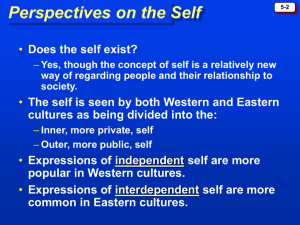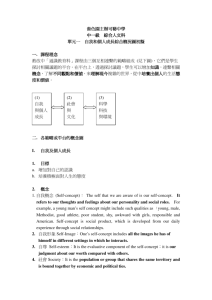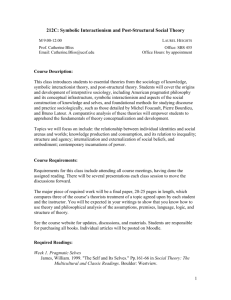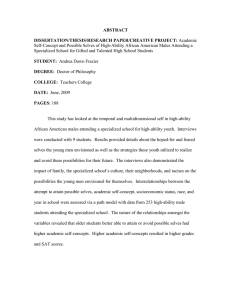Review5
advertisement
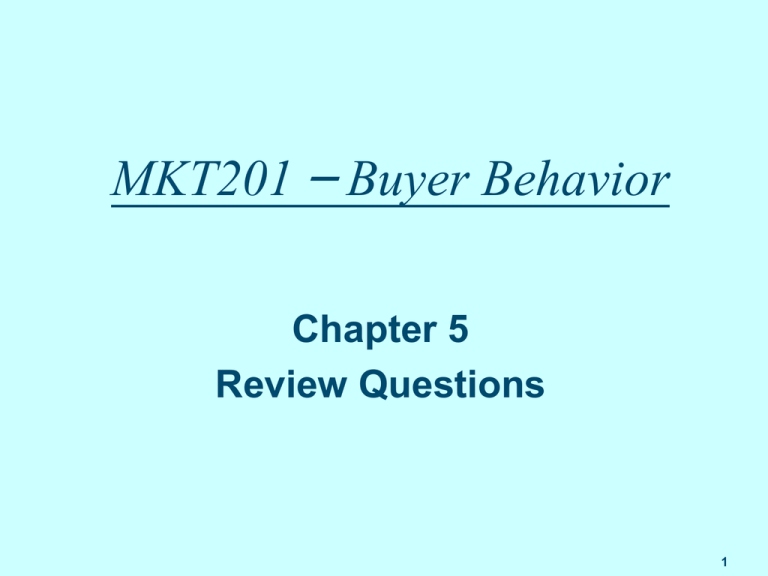
MKT201 – Buyer Behavior Chapter 5 Review Questions 1 1. Which of the following best defines what is implied by the symbolic self-completion theory? a. Customers tend to buy products that violate their self-concept if their self-esteem is low. b. Customers who have an incomplete self-concept tend to buy products that complete that concept. c. Customers delay purchases that conform to their actual self-image until their self-concept is consistent with their social self. d. Customers select products that conform to their self-image through a process that is largely subconscious. 2 2. The body is adorned or altered in some way in every culture. Decorating the self serves a number of purposes. Which of the following is not one of those purposes? a. To separate group members from non–group members b. To place the individual in the social organization c. To place the individual in a gender category d. To enhance age-status identification 3 3. Attributes of self-concept can be described along several dimensions. If Rudi Gonzalez sees himself as being one who is handsome (has a highly attractive face) rather than a person who is intellectual, which of the following self-concept dimensions best applies to Rudi's view of himself? a. b. c. d. Content Positivity Intensity Stability over time 4 4. Mary Jane is a very conservative businesswoman by day. However, when she decides to "go out on the town," she likes to party and "kick up her heels." This would be an example of a reaction due to the fact that many consumers _________. a. b. c. d. are psychotic have multiple selves are not confident with their real selves prefer their ideal self 5 5. Grace Norris is a 50-year-old housewife who recently selected Chrysler's PT Cruiser as her new car. To some extent, she selected the car because it is practical and has ample storage space for groceries and other items she gets on her many shopping trips. On the other hand, she also confesses that she selected the car because of its "bad boy" image. "It looks like a gangster car from the 1930s," says Grace. "It says 'don't mess with me,' " she tells her friends. Grace is exhibiting _________ in her selection of a car. a. b. c. d. Gestaltism symbolic consumerism symbolic interactionism Draconian fantasies 6 6. Arthur was asked to speak in front of a group of downtown business persons during the noon hour. He noticed that as he spoke, one person appeared to be napping and another frowned during the entire presentation. "I'm not going to do that again," Arthur promised himself. "I am not a good public speaker." Which of the following terms best reflects Arthur's perception of himself and his ability as a speaker? a. b. c. d. Multiple selves Ideal self Actual self Looking-glass self 7 7. Jane Jones loves liver and onions. She often sees this dish available in cafeterias. However, she has also overheard fellow cafeteria patrons commenting that "only old people eat liver—how disgusting!" Because of the social criticism that she has overheard, she almost never buys liver and onions when she is out in public. Jane would best be characterized as being a(n) _______. a. b. c. d. high self-monitor medium self-monitor low self-monitor image-resistant consumer 8 8. Bart was a mortuary worker who noticed that there seemed to be a social class difference in what people placed on the graves of departed family members. What Bart observed was a class difference in how people manifest the relationship between external objects and the _________ self. a. b. c. d. extended actual social looking-glass 9 9. Fred Johnson lives, eats, and breathes pro football. His favorite team is the Dallas Cowboys. His home looks like a Dallas Cowboys' museum. Which of the following categories or levels of the extended self would most likely apply to Fred's situation? a. b. c. d. Family level Individual level Community level Group level 10 10. One study of young male beer drinkers found a segment that was characterized as "losers." These were men who worked hard but had little chance of promotion, and although they enjoyed life, thought that they were never going to get ahead. Beer ads made to this segment had a very high fantasy appeal. What relationship between the concepts of self in this segment was being assumed by the marketers? a. This segment had a strong looking-glass self. b. This segment had a large gap between their real and ideal selves. c. This segment had low self-esteem. d. This segment had a culturally defined inner self that was much different from their public self. 11 Essay Questions: 1. Briefly comment on gender differences in socialization, female sex roles, and male sex roles in our society. – In many societies, males are controlled by agentic goals, which stress self-assertion and mastery. Females, on the other hand, are taught to value communal goals, such as affiliation and the fostering of harmonious relations. – Each society creates a set of expectations regarding the behaviors appropriate for men and women and finds ways to communicate these priorities. This training begins very early in a child's life. Today, the field of marketing tends to be dominated by male values. This, however, is changing. 12 Essay Questions: 2. Ben is a little nervous about how he will be perceived when he arrives for a job interview. He got his hair cut and wore his most expensive business suit so he would appear more like the person the firm would hire at an executive level. He knows that he "cleans up well" and hopes that will compensate for a weak resume. Explain in terms of symbolic interactionism what Ben is doing. – Symbolic interactionaism stresses the importance of how relationships with other people form our concepts of self. Members of the same group have shared meanings, which can be reflected by behavior, symbols, and products. – Although this is a new situation for Ben, his self-concept has been partially formed by how other people reacted to him in the past. He has defined himself as executive material because of this past treatment, and trusts that other people will share the same consensus when he presents the appropriate presentation with its symbolic meaning. 13
